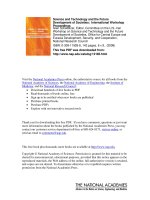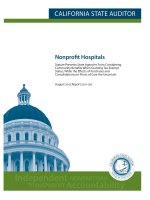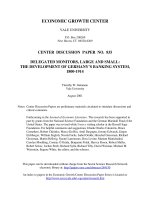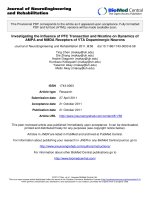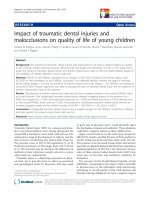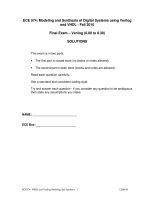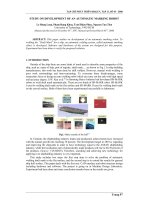Remote sesing modeling and synthesis on development of global ocean
Bạn đang xem bản rút gọn của tài liệu. Xem và tải ngay bản đầy đủ của tài liệu tại đây (25.68 MB, 78 trang )
This thesis for the Master of Science degree by
has been approved for the Department of
Aerospace Engineering Sciences
by
_____________________________________
Lakshmi H. Kantha
_____________________________________
Baylor Fox-Kemper
_____________________________________
William J. Emery
Date______________
The final copy of this thesis has been examined by the signatories, and we
find that both the content and the form meet acceptable presentation standards
of scholarly work in the above mentioned discipline.
iii
Erik Charles Baldwin Stevens (M.S., Aerospace Engineering Sciences)
Remote Sensing, Modeling, and Synthesis: On the Development of a Global Ocean
Wind/Wave Climatology and its Application to Sensitive Climate Parameters
Thesis directed by Professors Lakshmi Kantha and Baylor Fox-Kemper
In this study, data from TOPEX satellite altimetry is combined with ERA40
(ECMWF 40-year reanalysis) and non-data-assimilating WaveWatch3 model output
to develop a comprehensive 2.5ox2.5o monthly global climatology of wind and wave
properties useful in determining the global extent of Langmuir mixing. The
climatology is forged from data covering the years 1994 - 2001. The variables
mapped include: significant wave height, mean wave period, 10-meter atmospheric
wind speed, skin friction velocity, wind direction, and wave direction. Further
computation of surface Stokes drift and Langmuir number from these parameters
exhibits sensitivity to data from the climatology, demonstrating its applicability and
limitations for use as Langmuir turbulence forcing.
Agreement among the three data sources in the climatology is better than 90%
for most basic wind/wave variables in the climatology, with wave period and wave
direction showing the most disagreement. However, small disagreements in simple
wave parameters lead to large discrepancies (approaching 50-100%) in estimates of
Stokes drift and Langmuir number.
The average Langmuir number worldwide was found to be near 0.3 in regions
of aligned wind and waves, but significantly less in trade wind regions. Scatter
between the three sources in the average worldwide Langmuir number is 0.28 – 0.40,
with the best-guess world average being ~0.35. Further study of the resulting
iv
Langmuir number climatology reveals that the choice of Langmuir number definition
has an impact on the statistics of the result by skewing the resulting Langmuir number
histogram. Because of this, care should be taken to ensure proper use of means,
medians, and standard deviations.
This study shows that comparing data assimilating and non-assimilating
models illuminates the magnitude of missing model physics, and provides a check on
the usefulness of model data versus empirical data. Context is gained by comparing
multiple data sources rather than using just one.
This thesis is dedicated to my parents, Amy and Larry
vi
ACKNOWLEDGEMENTS
I cannot express enough gratitude to my advisors, Baylor Fox-Kemper and
Lakshmi Kantha for sharing their experience and opinions, and directing this research
to completion. I am very grateful for Dr. Fox-Kemper’s encouragement and
dedication to ensuring my success in both this thesis and my research career in
general. This work would not be as balanced or complete without the keen eye and
insight of Dr. Kantha. Finally, I greatly appreciate the effort put in by Adrean Webb
to generate data from the NOAA WaveWatch3 model, and that of Benjamin
Hamlington and the Colorado Center for Astrodynamics Research for supplying
satellite data.
This work was supported by NASA ROSES Physical Oceanography grant
NNX09AF38G, a CIRES Innovative Research Project and a University of Colorado
Innovative Seed Grant.
vii
CONTENTS
CHAPTER
I. Introduction ........................................................................................................ 1
1.1 Context .......................................................................................................1
1.2 Stokes Drift ................................................................................................2
1.3 Langmuir Mixing .......................................................................................3
1.4 Current Ocean Datasets ..............................................................................6
1.5 Thesis Overview .........................................................................................8
II. Methodology .................................................................................................... 10
2.1 Data Sources .............................................................................................10
2.1.1 TOPEX Altimetry .................................................................................11
2.1.2 ERA40 Reanalysis.................................................................................13
2.1.3 NOAA Wave Watch 3...........................................................................17
2.2 Data Reduction .........................................................................................19
2.3 Calculation of Stokes Drift .......................................................................22
2.4 Multimodel Ensemble Average ................................................................24
III. Results .............................................................................................................. 28
3.1 Primary Wind/Wave Variables and their Climatologies ..........................29
3.2 Secondary Variables .................................................................................33
IV.Discussion ........................................................................................................ 39
4.1 Wind Fields and Friction Velocity ...........................................................39
viii
4.2 Significant Wave Height ..........................................................................40
4.3 Mean Wave Period ...................................................................................42
4.4 Stokes Drift ..............................................................................................44
4.5 Langmuir and Kantha Numbers ...............................................................45
V. Conclusions and Recommendations ................................................................. 50
5.1 Conclusions ..............................................................................................50
5.2 Recommendations for Future Work .........................................................53
VI.References ........................................................................................................ 56
VII. Appendix A: Seasonal Climatology............................................................. 60
ix
TABLES
Table II-1: Summary of data ..................................................................... 10
Table IV-1: Langmuir/Kantha number statistics ...................................... 47
x
FIGURES
Figure II-1: ERA40 global mean wave height from 1958-2001. Data
assimilation periods 1-4 are marked by dashed boxes, with this study's data period
shown by the solid black box. Graph from Sterl and Caires (2005). .................... 16
Figure II-2: Mean wave period (s) from each data source for February 8th,
1993. Note that this day falls within period 2 of the ERA40data history (see
Section 2.1.2). ....................................................................................................... 21
Figure II-3: TOPEX mean - median inverse-square Langmuir number for
1993. Colorscale goes from -10 to 10. .................................................................. 22
Figure II-4: Average percent difference Usmr - Usapprox from WW3 .......... 24
Figure III-1: Legend for climatology ........................................................ 29
Figure III-2: Global zonal average of ten-meter wind speed from TOPEX
(blue), ERA40 (red), and WW3 (black)................................................................ 30
Figure III-3: Global zonal average of significant wave height from
TOPEX (blue), ERA40 (red), and WW3 (black) .................................................. 30
Figure III-4: Global zonal average of second-moment mean wave period
from TOPEX (blue), ERA40 (red), WW3 (black), and MME (green) ................. 31
Figure III-5: Global zonal average of wind direction from ERA40 (red)
and WW3 (black) .................................................................................................. 31
Figure III-6: Global zonal average of mean wave direction from ERA40
(red) and WW3 (black) ......................................................................................... 32
Figure III-7: Global zonal average of Cos() from ERA40 (red) and WW3
(black) ................................................................................................................... 32
xi
Figure III-8: Global average cos() from WW3. ...................................... 33
Figure III-9: Surface friction velocity from TOPEX (blue), ERA40 (red),
and WW3 (black) .................................................................................................. 34
Figure III-10: Surface Stokes drift from TOPEX (blue), ERA40 (red),
WW3 (black), and multimodel ensemble climatology (green). ............................ 34
Figure III-11: Seasonal zonal means of Stokes drift from multimodel
ensemble ............................................................................................................... 35
Figure III-12: Inverse-square turbulent Langmuir number from TOPEX
(blue), ERA40 (red), WW3 (black), and MME (green) ....................................... 35
Figure III-13: Multimodel ensemble inverse-square turbulent Langmuir
number (solid green) with 2- errorbars based on zonal variability (dashed black)
and time variability (dashed blue)......................................................................... 36
Figure III-14: Seasonal zonal means of inverse square Langmuir Number
from multimodel ensemble ................................................................................... 36
Figure III-15: Global average of multimodel ensemble La-2 .................... 37
Figure III-16: Multimodel ensemble Kantha number (solid green) with 2-
errorbars based on zonal variability (dashed black) and time variability (dashed
blue) ...................................................................................................................... 37
Figure III-17: Seasonal zonal means of Kantha Number from multimodel
ensemble ............................................................................................................... 38
Figure III-18: Map of global average multimodel ensemble Kantha
number .................................................................................................................. 38
xii
Figure IV-1: A) Global swell-sea probability from Chen et al. (2002), (the
color scale goes from 72 - 99%). B) Average 10-meter wind speed from ERA40
[m/s]. C) ERA40-TOPEX average difference in mean wave period [s]. ............. 43
Figure IV-2: Histograms of La, Ka, and La-2 .......................................... 47
1
I.
INTRODUCTION
1.1 Context
Attention in much of the scientific and political communities is
increasingly focusing on climate modeling and the resulting predictions of Earth’s
near future. Recent drastic changes in the natural environment (Rosenzweig et al.,
2007) have suddenly stepped out of the circles of the scientific community and
signaled the urgency of climate change in the practical, everyday world.
Consequently, scientific findings on the current state of the Earth system, such as
the 2007 International Panel on Climate Change (IPCC) report are facing
increasing importance and scrutiny.
The IPCC report represents a grand review of the recent work and research
on the climate and its changes, summarizing the most influential predictions and
results. The implications of the IPCC report are substantial to our economic and
societal futures, and as a result, public attention and political agendas have finally
begun to address these issues quite seriously. With this increased regard for
climate modeling, demands for accuracy of the predictions made and the
consequences of predictive error are becoming substantial.
The ability of a model to predict reality should depend on the extent to
which it accounts for the initial conditions (i.e. empirical environmental data) and
the accuracy to which it resolves all of the processes governing change (Sterl and
Caires, 2005). Thus, to be fully correct in our predictions about the future, we
2
must include completely accurate measurements of the environment, and correctly
simulate all of the processes that manipulate the present conditions into a future
state. The current state of computer climate models is an approximation of this
ideal representation. The models include many of the well-understood processes
as governing equations and many of the hard to model processes as
parameterizations. Still, there are likely many unknown contributors to global
climate that are left out. One example of a process missing from climate models is
explicit treatment of Langmuir turbulence and mixing – which is the motivation
for the work herein. The available initial data and forcing is sufficient and mostly
accurate, though spatial and temporal coverage is generally lacking over the open
ocean. Still, there will always be much unknown about the Earth system as a
whole, and there will always be pieces missing from our climate models.
1.2 Stokes Drift
In the absence of surface currents, the motion of a particle at the ocean
surface is tied to the motion of surface gravity waves. As a wave propagates under
the particle, the particle is thrust up and forward horizontally along the surface
until the ridge of the wave is underneath. The particle then falls down and
backward horizontally as the wave propagates away. In this way, the particle’s
path makes an elliptical orbit with the period of the wave. However, this orbit is
not closed. The particle actually travels further in the direction of wave
propagation than it falls backwards as the wave moves away. As a result, the
ocean surface exhibits a mean velocity in the direction of the wave field, due only
3
to the motion of the waves themselves. This velocity is referred to as the Stokes
drift (Kantha and Clayson, 2000).
Stokes drift is important because it acts as a source of energy to generate
additional turbulence in the oceanic mixed layer (Kantha and Clayson, 2000).
Stokes drift decays exponentially with depth, creating shear. This shear extracts
energy from the wave field, converting it to turbulence. It is estimated that this
energy extraction from the wave field is as significant worldwide as energy
dissipation found in surf zones at the ocean edges (Kantha et al. 2009).
Additionally, the vorticity created by Stokes drift at the ocean surface provides for
the genesis of Langmuir mixing (Kantha and Clayson, 2000).
1.3 Langmuir Mixing
One phenomenon presently missing explicit treatment in global climate
models is Langmuir mixing due to Langmuir cells and Langmuir turbulence
(Sullivan, McWilliams & Moeng 97, Sullivan & McWilliams, 2010). Commonly
named windrows, Langmuir cells are known to enhance vertical mixing in the
upper mixed layer of the ocean wherever they exist (e.g., Plueddemann et al.,
1996, D’Asaro & Dairiki, 1997). Because of this enhanced mixing they have an
effect on sea surface temperature, near-surface stratification, and energy,
momentum, and gas fluxes, which are key factors in worldwide climate.
Langmuir cells appear in long vortex pairs aligned parallel to the wind and
wave directions (or between the two). The spacing between cells is usually 5-300
meters. Vertical velocities between the cells are quite high at 2-6 cm/s
4
downwelling and 1-2 cm/s upwelling. For this reason, Langmuir cells are capable
of significant vertical transport of gases, momentum, turbulence, and energy in
the ocean mixed layer (Kantha and Clayson, 2000). Langmuir turbulence is a
more disorganized form of near surface overturning, with overturning cells
elongated in roughly the wave and wind direction (Sullivan and McWilliams,
2010) and vertical kinetic energies that exceed the scaling from solid-wall
boundary layers (D’Asaro and Dairiki, 1997) by a factor of 1.5-5.
There is ongoing debate on how strong, deep, and influential Langmuir
cells are to sea surface temperature and other important processes, as well as the
extent to which they occur in the world’s complex and meagerly mapped oceans.
They appear to generate and decay quickly and are therefore hard to study in the
field (Kantha and Clayson, 2000). Climate models do not explicitly include any
Langmuir cell physics, instead simply matching the depth of the mixed layer to
available measurements. While this may be sufficient to map upper-ocean mixing
in some areas, there are other regions, e.g. the Southern Ocean, where a persistent
shallow bias exists in the modeled mixed layer depths. Ongoing work by Webb et
al. (2010) is closely investigating how climate models react to the inclusion of
Langmuir mixing, but there is still disagreement in the computation of turbulent
Langmuir number, a parameter thought to be involved in controlling the strength
of Langmuir mixing at any location (e.g., Harcourt & D’Asaro 2008). Though the
principle of the Langmuir number (La), that the strength of Langmuir mixing is
proportional to the ratio of surface Stokes drift velocity to wind friction velocity,
5
is agreed upon, the scaling of the relationship is still uncertain. Additionally, the
exact response of Langmuir mixing to misalignment of the wind and waves is
poorly understood. For this study, a common approximation for this response is
used: La is proportional to the cosine of the angle between the wind and waves, as
evidenced by the dot product in Eqs. 1 below.
The scaling of La can generally be thought of in three different forms. One
of these forms, the Kantha number (after Lakshmi Kantha, who proposed it),
provides a sound logical basis for the computation: that Kantha number increases
as wave activity increases and scales precisely with the Stokes production term of
energy. For this study, the Kantha number and the inverse-square of the Langmuir
number (La-2) (Eqs. 1) are presented side by side for comparison.
(1)
…where Us is Stokes drift and u* is ocean surface friction velocity due to wind.
The main uncertainties in Langmuir number computation involve
knowledge of the global ocean wind and wave state. Computed from a few key
variables (wave height, wave period, wind speed, and wind and wave directions),
the Langmuir number is quite sensitive to small changes in wave height and
period. Thus, large errors can easily result from inaccuracies in the current wind
and wave datasets.
6
A key issue is uncovered by the inclusion of Langmuir number in climate
models: the important end projections from climate models may depend greatly
on sensitive reactions to the wind and ocean wave forcing. Small errors in the
wind/wave climatology may therefore introduce large, unreal disturbances to the
modeled climate. This is a manifestation of a principle that seems obvious: if we
wish to clearly map and understand the Earth system as a whole, we must first
understand its most basic pieces. A goal of this work is to quantify the likely
values and uncertainty in different estimates of these variables, so that future
climate model predictions of these variables can be checked for agreement with
extant data.
1.4 Current Ocean Datasets
Satellite-retrieved wave data is a great resource because of its empirical
nature and near global coverage. Satellite altimeters can directly and accurately
measure wave height, and properties of the returned altimeter radar beam can
indirectly give us information about the wind speed, wave period, and other
important oceanographic parameters (see Gourrion et al., 2002, Vandemark et al.,
1996, Gommenginger et al., 2003, etc.). Unfortunately, these indirectly measured
data are based on empirical fits, and there is enough scatter around the fits to
generate significant potential errors. Satellite altimetry is discussed in more detail
in Section 2.1.1.
Additional ocean data can be retrieved from networks of floating
instruments. These include ARGO floats, moored buoy arrays, and surface
7
drifters. There have also been several large-scale ship-based research campaigns
to map the properties of the world’s oceans. Though the ship data is thorough, its
coverage in time and space is insufficient for creating a climatology of the
average world ocean. Similar problems exist for moored buoy arrays due to their
locations near continental shelves and shores, and non-continuous time coverage.
ARGO floats may provide some of the data needed to create a climatology, and
could be an important source of comparison data.
A model dataset, the EMCWF Reanalysis (ERA40), assimilates empirical
wind and wave data to generate comprehensive global wind and wave fields for
the past half-century. The primary focus of the ERA40 is the global atmospheric
state, and the wave field is used to improve the air-sea momentum transfer (and
also to estimate the wave field). Aside from the wave model, there is not a full
ocean model in ERA40, thus it is not a true climate model. While certain aspects
(wave height and wind speed, for example) of the climatology created from
ERA40 are quite robust, others (wave period and direction) are still open to
question. There is disagreement in these variables between ERA40 and other
models, as well as satellite wave data. It should be noted that while satellite and
buoy wave data are assimilated in ERA40, buoy data is sparse and the only
satellite data assimilated is significant wave height (not period or other variables).
There has been much work done to validate the ERA40 data (see Section2.1.2),
and regions of error have been uncovered.
8
1.5 Thesis Overview
While considerable work has gone into comparing certain variables
between the various wind and wave datasets available (see Caires et al., 2004,
Bidlot et al., 2002, Hanson et al. 2009, Hwang et al. 1998, etc), no work has yet
been done to fully quantify the differences between their methods and reconcile
the disagreement between their results. There is a need for the models and
observations to be combined into a comprehensive picture of the characteristic
Earth wind and wave fields. A question remains: How can information from
satellites, computer models, and in situ observations be accurately combined to
represent this complex and dynamic truth?
This study sets out to answer this question. A new ocean wind/wave
climatology (a multimodel ensemble average) is developed for the following
variables: significant wave height (Hs), mean second-moment wave period (Tm),
10-meter wind speed and direction (U10), surface friction velocity (u*), and
surface Stokes drift (Us) magnitude and direction. It is hoped that this dataset will
validate the accuracy of future parameterizations and models of natural wind and
wave phenomena, leading to a better understanding of Earth’s dynamic climate
system and the role of remote sensing and modeling in climate science.
The usefulness of the new climatology is demonstrated by a case study in
which the climatology data is used to compute the highly sensitive inverse-square
Langmuir (La-2) and Kantha (Ka) numbers. This new Langmuir mixing
9
climatology will answer the question: how strong and prevalent is Langmuir
mixing worldwide?
10
II.
METHODOLOGY
2.1 Data Sources
Three overlapping sources were used in this study to compile the
wind/wave climatologies so as to reconcile any differences and cover any
shortcomings in the data. The three data sources are TOPEX satellite altimetry,
the European Center for Medium-Range Weather Forecasts’ (ECMWF) oceanatmosphere model reanalysis (ERA40), and the NOAA WaveWatch3 (WW3)
model. They were chosen because they represent a subset of three independent
wave data sources overlapping globally, from which the study period was chosen
to be from 1994 to 2001. While there are other satellite altimeters that could have
been used for this study, TOPEX provides the longest contiguous satellite record
from one instrument and has been highly validated and scrutinized in the
literature; its properties and retrievals have been well-studied. An overview of
each data source is found in Table II-1.
Table II-1: Summary of data
Source
Strengths
Weaknesses
Spatial Coverage
Temporal Coverage
TOPEX
Hs (4cm)
~Global, (66oN to
66oS lat.)
~10 day repeat
period, 1993 – 2001
ERA40
Hs, U10
Everything
else
(mostly)
Data
assimilation
periods
Global
Every 6 hours, 1957 –
2002
WW3
2D
spectrum
Stokes
drift
Forcing
field is
arbitrary, no
assimilation
Global
Every 3 hours, as
desired
11
2.1.1 TOPEX Altimetry
TOPEX altimetry consists of Ku-band radar altimeter data, retrieved
remotely aboard a satellite orbiting at 1336km above the ocean surface. The
altimeter data is collected in a pushbroom architecture, with passes inclined at 66o
to the equator. By measuring once per second, it provides data with roughly 7km
resolution. The repeat period for any given point is roughly ten days (Hwang et
al., 1998).
TOPEX data is not truly global in coverage since the satellite orbit
inclination limits data coverage to 66oN to 66oS. The lack of coverage poleward
of 66o latitude is inconsequential for this study, as sea ice or landmass dominates
much of this area for much of the year. Based on current literature, the bulk of
current interest in wind-wave interaction is focused on the ice-free open ocean –
the area to which this study pertains.
Wave height (Hs) is the characteristic oceanographic parameter retrieved
by TOPEX. The instrument sends out 4,000 pulses per second, and averages these
data into one-second measurements. Wave height is then determined from the
average radar return waveform variance, with a nominal accuracy of 4-5cm
(Chelton et al., 1989).
TOPEX also returns the normalized radar cross section for each
measurement, and the empirical model of Gourrion et al. (2002) is used to covert
this into 10-meter wind speed (U10). The U10 data was calculated and furnished by
12
Benjamin Hamlington at the Colorado Center for Astrodynamics Research
(CCAR) in Boulder, CO.
Given u10, the models of Vandemark et al. (1996) and Gommenginger et
al. (2003) are used to find the friction velocity (u*) and mean wave period (Tm)
(both also furnished by Benjamin Hamlington) respectively, as follows:
For U10 < 2.4m/s:
1
10
1/ 2
Cd10 [( ) ln(Cd10 U 10 ) 5.5] 2
(2)
For U10 > 2.4m/s:
1
10
1/ 2
Cd10 [( ) ln(Cd10 U 10 ) 5.5] 2
Then,
u* Cd 10
1/ 2
U 10
(3)
And,
Tm 0.895 2.545P
(4)
Where,
P ( 0 H s ) 0.25
2
(5)
Gourrion et al. (2002) report that altimeter backscatter is proportional to
both wind speed and sea state, and thus sea state biases are corrected for in the
U10 model. The result is a wind-independent bias of less than 0.3m/s in TOPEX
u10 as compared to buoys, models, and satellite scatterometers.
Vandemark et al. (1996) found their model (Eqs. 2 and 3) to produce a
roughly 0.02m/s bias in u*, with a root-mean square-error (RMSE) near 0.038m/s
13
versus in situ (ship-derived) observations. They also demonstrated that higher
accuracies can be achieved by directly correlating u* to radar cross section (o),
rather than deriving U10 from o and then u* from U10. However, a well-tested
model as such was not available for this study.
The Tm relationship used here (Eq. 4) is derived from regression against
buoy wave period data, with a reported RMSE of roughly 0.98s (about 7%)
(Gommenginger et al., 2003). An extensive study by Caires et al. (2005) shows
that the Gommenginger Tm model is biased in swell-dominated seas and for wind
speeds less than 10m/s. With these points removed, they found the TOPEXERA40 RMSE to be 0.77s.
2.1.2 ERA40 Reanalysis
The ERA40 dataset, completed in 2004, is a 45-year reanalysis run of the
European
Center
for
Medium-Range
Weather
Forecasts
(ECMWF)
meteorological (atmosphere) model, coupled to a 3rd-Generation WAM wave
model (Komen et al., 1994). The coupling consists of the 10-meter wind speed,
U10, from the atmosphere model being passed to the wave model every four time
steps (hourly). The WAM 3.0 wave model used in ERA40 uses energy balance
equations to derive the full wave spectrum without any restriction of its spectral
shape. Wave parameters (Hs, Tm, etc.) are accurately calculated by integrating this
full wave spectrum, and then the wave spectrum itself is deleted (Sterl and Caires,
2005). Since the spectrum is not saved, some additional wave parameters (e.g.
Stokes Drift) can not be directly calculated, but must be approximated from the
